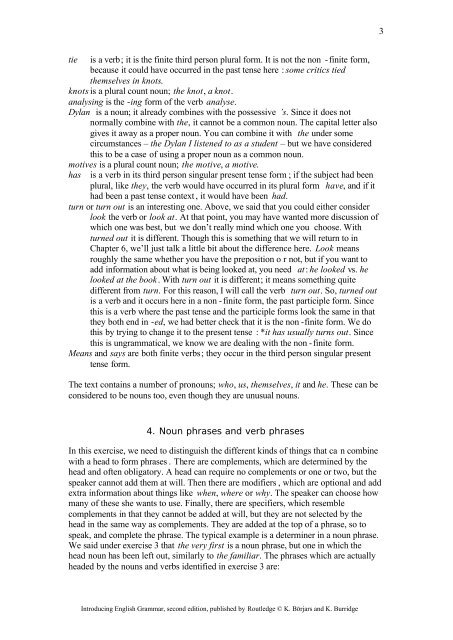Answers to exercises: Chapter 3
Answers to exercises: Chapter 3
Answers to exercises: Chapter 3
Create successful ePaper yourself
Turn your PDF publications into a flip-book with our unique Google optimized e-Paper software.
3tie is a verb; it is the finite third person plural form. It is not the non -finite form,because it could have occurred in the past tense here : some critics tiedthemselves in knots.knots is a plural count noun; the knot, a knot.analysing is the -ing form of the verb analyse.Dylan is a noun; it already combines with the possessive ’s. Since it does notnormally combine with the, it cannot be a common noun. The capital letter alsogives it away as a proper noun. You can combine it with the under somecircumstances – the Dylan I listened <strong>to</strong> as a student – but we have consideredthis <strong>to</strong> be a case of using a proper noun as a common noun.motives is a plural count noun; the motive, a motive.has is a verb in its third person singular present tense form ; if the subject had beenplural, like they, the verb would have occurred in its plural form have, and if ithad been a past tense context , it would have been had.turn or turn out is an interesting one. Above, we said that you could either considerlook the verb or look at. At that point, you may have wanted more discussion ofwhich one was best, but we don’t really mind which one you choose. Withturned out it is different. Though this is something that we will return <strong>to</strong> in<strong>Chapter</strong> 6, we’ll just talk a little bit about the difference here. Look meansroughly the same whether you have the preposition o r not, but if you want <strong>to</strong>add information about what is being looked at, you need at: he looked vs. helooked at the book. With turn out it is different; it means something quitedifferent from turn. For this reason, I will call the verb turn out. So, turned outis a verb and it occurs here in a non -finite form, the past participle form. Sincethis is a verb where the past tense and the participle forms look the same in thatthey both end in -ed, we had better check that it is the non -finite form. We dothis by trying <strong>to</strong> change it <strong>to</strong> the present tense : *it has usually turns out. Sincethis is ungrammatical, we know we are dealing with the non -finite form.Means and says are both finite verbs; they occur in the third person singular presenttense form.The text contains a number of pronouns; who, us, themselves, it and he. These can beconsidered <strong>to</strong> be nouns <strong>to</strong>o, even though they are unusual nouns.4. Noun phrases and verb phrasesIn this exercise, we need <strong>to</strong> distinguish the different kinds of things that ca n combinewith a head <strong>to</strong> form phrases . There are complements, which are determined by thehead and often obliga<strong>to</strong>ry. A head can require no complements or one or two, but thespeaker cannot add them at will. Then there are modifiers , which are optional and addextra information about things like when, where or why. The speaker can choose howmany of these she wants <strong>to</strong> use. Finally, there are specifiers, which resemblecomplements in that they cannot be added at will, but they are not selected by thehead in the same way as complements. They are added at the <strong>to</strong>p of a phrase, so <strong>to</strong>speak, and complete the phrase. The typical example is a determiner in a noun phrase.We said under exercise 3 that the very first is a noun phrase, but one in which thehead noun has been left out, similarly <strong>to</strong> the familiar. The phrases which are actuallyheaded by the nouns and verbs identified in exercise 3 are:Introducing English Grammar, second edition, published by Routledge © K. Börjars and K. Burridge
















